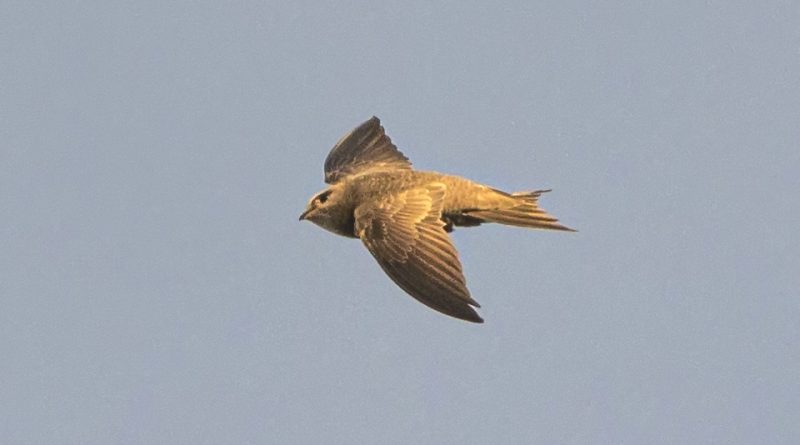Apus pallidus
Apus pallidus
The palllid swift (Apus pallidus Shelley, 1870) is a bird belonging to the Apodidae family.
Systematic –
From a systematic point of view it belongs to:
Eukaryota domain,
Kingdom Animalia,
Phylum Chordata,
Aves class,
Subclass Neornithes,
Superorder Neognathae,
Order Apodiformes,
Family Apodidae,
Subfamily Apodinae,
Genus A. pallidus.
The term is basionym:
– Cypselus pallidus Shelley, 1870.
The following subspecies are recognized within this species:
– Apus pallidus brehmorum Hartert, E, 1901;
– Apus pallidus illyricus von Tschusi, 1907;
– Apus pallidus pallidus Shelley, 1870.
Geographic Distribution and Habitat –
The Apus pallidus is a bird widespread in southern Europe, Africa and the Middle East.
Its breeding range extends around the Mediterranean Sea and the coastal regions of the Middle East, it also occupies some scattered areas of the interior of North Africa, the Canary Islands and Madeira.
Its habitats are those of coastal and mountain areas, nesting in the crevices of cliffs and ravines, as well as in caves, but it can also be found feeding while flying over any surrounding habitat, including human populations.
Description –
The Apus pallidus is a bird with long wings, forked tail and short legs, measuring 16 to 17 cm from bill to tail and has a wingspan of between 42 and 46 cm.
Its plumage is greyish-brown except the throat, which is whitish. It differs from the common swift, as well as for the tone that is difficult to appreciate in flight, because the whitish area of the throat is more extensive and the wings are slightly less pointed and have slightly darker front edges. As in other swifts, the young have pale edges of the feathers.
There is no sexual dimorphism, so externally the male and female are the same.
The male and the female have, in fact, an identical livery with a predominantly dark brown color, with the exception of the whitish throat. The legs are very short and normally not visible. The beak is very short, wide and blackish. The wings are sickle-shaped. The coloration of juveniles is similar to that of adults.
Biology –
The Apus pallidus chooses the slits or holes on the external walls of buildings for nesting. The effort involved in brooding and looking after the young is equally distributed between male and female, except for the first ten days, in which the females show greater effort. They practice monogamy, although a small percentage change both nest and partner.
It generally nests from May to June, laying 2 to 3. It can have 2 broods per season. The reproductive period thus culminates for many specimens in October and exceptionally they can be observed at the beginning of November.
At the end of the breeding season, it migrates to Africa to spend the winter in a wide band south of the Sahara, but also on the coasts of eastern Iran and western Pakistan.
A monitoring study of pale swifts breeding in Gibraltar, using GPS technology, has shown that they have more African wintering areas south of the Sahara that they inhabit at certain times of the year. An individual followed for two consecutive winters showed remarkable fidelity to the areas visited in Africa over the years. The study also supports previous findings of a fully aerial existence in swifts outside the breeding season, with two pallid swifts giving no indication of landing.
Ecological Role –
The Apus pallidus is a bird that practically spends its entire life in flight, even managing to sleep. It stops only during reproduction and feeding activities of the young, alighting near the nest. The flight is powerful, fast and erratic, with sudden turns.
It feeds by catching flying insects with its mouth, it can also catch spiders. It is also capable of drinking and sleeping in flight. His voice, a disyllabic cry, is very characteristic.
THERE. pallidus has a large range, estimated between 1,000,000 and 10,000,000 km². In Europe the estimated population is 77,000-320,000 specimens. Its reproduction is limited to southern Europe.
The IUCN Red List classifies Apus pallidus as a species of Least Concern.
Guido Bissanti
Sources
– Wikipedia, the free encyclopedia.
– GBIF, the Global Biodiversity Information Facility.
– C.Battisti, D. Taffon, F. Giucca, 2008. Atlas of nesting birds, Gangemi Editore, Rome.
– L. Svensson, K.Mullarney, D. Zetterstrom, 1999. Guide to the Birds of Europe, North Africa and the Near East, Harper Collins Publisher, United Kingdom.
Photo source:
– https://inaturalist-open-data.s3.amazonaws.com/photos/267914885/original.jpg


